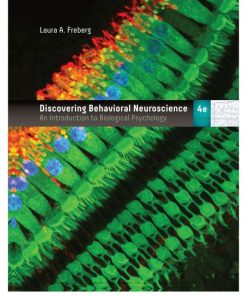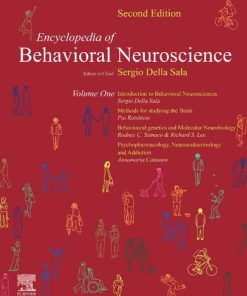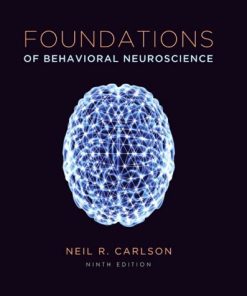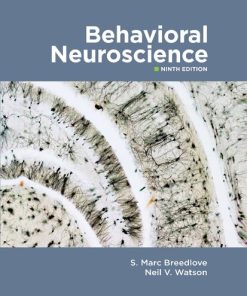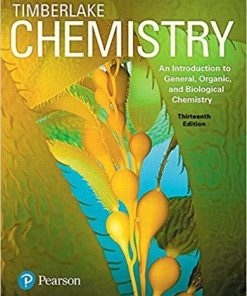(Ebook PDF) Discovering behavioral neuroscience an introduction to biological psychology Fourth Edition by Laura Freberg ISBN 9798214341 1337570931 full chapters644
$50.00 Original price was: $50.00.$25.00Current price is: $25.00.
(Ebook PDF) Discovering behavioral neuroscience an introduction to biological psychology Fourth Edition by Laura Freberg –Ebook PDF Instant Download/Delivery:9798214341644,1337570931
Instant download Full Chapter of Discovering behavioral neuroscience an introduction to biological psychology Fourth Edition after payment
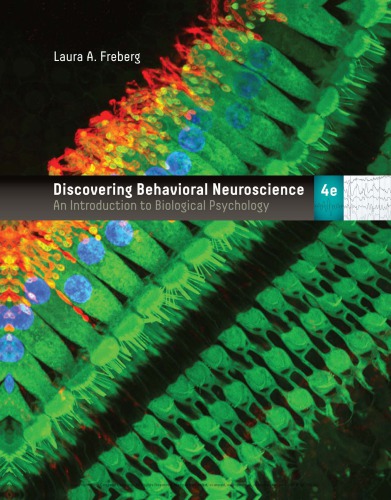
Product details:
ISBN 10: 1337570931
ISBN 13: 9798214341644
Author: Laura Freberg
Table of Contents:
- Chapter 1. What Is Behavioral Neuroscience?
- Neuroscience as an Interdisciplinary Field
- Historical Highlights in Neuroscience
- Ancient Milestones in Understanding the Nervous System
- The Dawn of Scientific Reasoning
- Modern Neuroscience Begins
- Behavioral Neuroscience Research Methods
- Microscopic Methods
- Imaging
- Recording
- Brain Stimulation
- Lesion
- Biochemical Methods
- Genetic Methods
- Research Ethics in Behavioral Neuroscience
- Human Participant Guidelines
- Animal Subjects Guidelines
- Thought Questions
- Key Terms
- Chapter 2. Functional Neuroanatomy and the Evolution of the Nervous System
- Anatomical Directions and Planes of Section
- Protecting and Supplying the Nervous System
- Meninges
- Cerebrospinal Fluid
- The Brain’s Blood Supply
- The Central Nervous System
- The Spinal Cord
- Embryological Divisions of the Brain
- The Hindbrain
- The Midbrain
- The Forebrain
- The Peripheral Nervous System
- The Cranial Nerves
- The Spinal Nerves
- The Autonomic Nervous System
- The Endocrine System
- The Evolution of the Human Nervous System
- Natural Selection and Evolution
- Evolution of the Nervous System
- Evolution of the Human Brain
- Thought Questions
- Key Terms
- Chapter 3. Neurophysiology: The Structure and Functions of the Cells of the Nervous System
- Glia and Neurons
- Glia
- The Structure of Neurons
- Structural Variations in Neurons
- Functional Variations in Neurons
- Generating Action Potentials
- The Ionic Composition of the Intracellular and Extracellular Fluids
- The Movement of Ions
- The Resting Potential
- The Action Potential
- Propagating Action Potentials
- The Synapse
- Gap Junctions
- Chemical Synapses
- Axo-axonic Synapses
- Thought Questions
- Key Terms
- Chapter 4. Psychopharmacology
- Neurotransmitters, Neuromodulators, and Neurohormones
- Identifying Neurochemicals
- Types of Neurochemicals
- Mechanisms of Neuropharmacology
- Agonists and Antagonists
- Production of Neurochemicals
- Neurochemical Storage
- Neurochemical Release
- Receptor Effects
- Reuptake and Enzymatic Degradation
- Basic Principles of Drug Effects
- Administration of Drugs
- Individual Differences in Responses to Drugs
- Placebo Effects
- Tolerance and Withdrawal
- Addiction
- Effects of Selected Psychoactive Drugs
- Stimulants
- Opioids
- Cannabis
- LSD
- Alcohol
- Thought Questions
- Key Terms
- Chapter 5. Genetics and the Development of the Human Brain
- The Genetic Bases of Behavior
- From Genome to Trait
- Sources of Genetic Variability
- Heritability
- Epigenetics
- Building a Brain
- Prenatal Development
- Effects of Experience on Development
- Disorders of Nervous System Development
- The Brain Across the Lifespan
- Brain Changes during Adolescence and Adulthood
- Adult Neurogenesis
- Healthy Brain Aging
- Thought Questions
- Key Terms
- Chapter 6. Vision
- From Sensation to Perception
- The Visual Stimulus: Light
- The Advantages of Light as a Stimulus
- The Electromagnetic Spectrum
- Light Interacts with Objects
- The Structure and Functions of the Visual System
- Protecting the Eye
- The Functional Anatomy of the Eye
- The Layered Organization of the Retina
- The Photoreceptors
- Processing by Retinal Interneurons
- Optic Nerve Connections
- The Striate Cortex
- Visual Analysis beyond the Striate Cortex
- Visual Perception
- Hierarchies
- Spatial Frequencies
- The Perception of Depth
- Coding Color
- The Life-Span Development of the Visual System
- Disorders of the Visual System
- Amblyopia
- Cataracts
- Visual Acuity Problems
- Blindness
- Visual Agnosias
- Thought Questions
- Key Terms
- Chapter 7. Nonvisual Sensation and Perception
- Audition
- Sound as a Stimulus
- The Structure and Function of the Auditory System
- Auditory Perception
- Hearing Disorders
- The Body Senses
- The Vestibular System
- Touch
- Pain
- The Chemical Senses
- Olfaction
- Gustation
- Synaesthesia
- Thought Questions
- Key Terms
- Chapter 8. Movement
- Muscles
- Types of Muscles
- Muscle Anatomy and Contraction
- The Effects of Exercise on Muscle
- The Effects of Aging on Muscles
- Neural Control of Muscles
- Alpha Motor Neurons
- The Motor Unit
- The Control of Muscle Contractions
- The Control of Spinal Motor Neurons
- Reflex Control of Movement
- Reciprocal Inhibition at Joints
- The Flexor Reflex
- Spinal Reflexes Related to Walking
- Reflexes over the Lifespan
- Motor Systems of the Brain
- Spinal Motor Pathways
- The Cerebellum
- The Basal Ganglia
- The Motor Cortex
- Disorders of Movement
- Toxins
- Myasthenia Gravis
- Muscular Dystrophy
- Polio
- Accidental Spinal Cord Injury (SCI)
- Amyotrophic Lateral Sclerosis (ALS; Lou Gehrig’s Disease)
- Parkinson’s Disease
- Huntington’s Disease
- Thought Questions
- Key Terms
- Chapter 9. Homeostasis, Motivation, and Reward
- Homeostasis and Motivation
- Regulating Body Temperature
- Adaptations Maintain Temperature
- Endothermic Responses to Heat and Cold
- Deviations in Human Core Temperature
- Brain Mechanisms for Temperature Regulation
- Thirst: Regulating the Body’s Fluid Levels
- Intracellular and Extracellular Fluid Compartments
- Osmosis Causes Water to Move
- The Kidneys
- The Sensation of Thirst
- Hunger: Regulating the Body’s Supply of Nutrients
- The Process of Digestion
- The Pancreatic Hormones
- The Initiation of Eating
- Satiety
- Healthy and Disordered Eating
- Defining Healthy Weight
- Obesity
- Disordered Eating
- Pleasure and Reward
- Multiple Facets of Reward
- Reward Pathways
- The Neurochemistry of Reward
- Cortical Processing of Reward
- Thought Questions
- Key Terms
- Chapter 10. Sexual Behavior
- Sexual Development
- The Genetics of Sex
- Three Stages of Prenatal Development
- Development at Mini-puberty
- Development at Puberty
- Sex Differences in Hormones, Brain Structure, and Behavior
- The Organizing Role of Sex Hormones
- The Organizing Role of Sex Chromosome Genes
- Sexual Dimorphism in the Brain
- Sex Differences in Behavior and Cognition
- Sexual Orientation
- Hormones and Sexual Orientation
- Brain Structure and Sexual Orientation
- Genes and Sexual Orientation
- Sexual Orientation and Cognition
- Biological Influences on Adult Sexual Behavior
- The Regulation of Sex Hormones
- Mood, Menstruation, and Childbirth
- Hormones and Adult Sexual Behavior
- Attraction, Romantic Love, Sexual Desire, and Parenting
- Elements of Physical Attractiveness
- Romantic Love and Sexual Desire
- Reproduction and Parenting
- Sexual Dysfunction and Its Treatment
- Thought Questions
- Key Terms
- Chapter 11. Sleep and Waking
- Biorhythms
- Individual Variations in Sleep Patterns
- Shift Work, Jet Lag, and Daylight Saving Time
- The Body’s Internal Clocks Manage Circadian Rhythms
- Major Depressive Disorder with Seasonal Pattern
- Neural Correlates of Waking and Sleep
- Electroencephalogram Recordings of Waking and Sleep
- Brain Networks Control Waking and Sleep
- Biochemical Correlates of Waking and Sleep
- The Functions of Sleep
- Changes in Sleep over the Lifetime
- Possible Advantages of Sleep
- Special Benefits of REM Sleep
- The Possible Functions of Dreaming
- Sleep–Wake Disorders
- Insomnia
- Narcolepsy
- Breathing-Related Sleep Disorders
- Sudden Infant Death Syndrome (SIDS)
- Sleep Talking and Sleep Walking
- REM Sleep Behavior Disorder
- Restless Legs Syndrome (RLS)
- Thought Questions
- Key Terms
- Chapter 12. Learning and Memory
- Categorizing Learning and Memory
- Types of Learning
- Types of Memory
- Mechanisms of Synaptic Plasticity
- Learning in Simple Organisms
- Long-Term Potentiation (LTP)
- Working Memory
- Memory Consolidation
- Reactivation and Reconsolidation
- Neural Systems Supporting Learning and Memory
- Early Efforts to Locate Memory Functions
- Systems Supporting Classical Conditioning
- The Temporal Lobe and Episodic Memory
- Semantic Memory Networks
- Systems Supporting Working Memory
- Systems Supporting Procedural Memory
- The Effects of Stress and Healthy Aging on Learning and Memory
- Stress Effects on Memory
- The Effects of Healthy Aging on Memory
- Thought Questions
- Key Terms
- Chapter 13. Cognitive Neuroscience
- Understanding Cognitive Neuroscience
- Hemispheric Asymmetry and Its Behavioral Correlates
- Learning About Asymmetry
- The Evolution of Lateralization
- The Development of Lateralization
- Implications of Asymmetry for Behavior
- Language
- The Origins of Language
- Communication in Nonhuman Animals
- Multilingualism
- American Sign Language (ASL)
- Communication Disorders and Brain Mechanisms for Language
- Paul Broca and Patient Tan
- Aphasia
- Disorders of Reading and Writing
- Stuttering
- Intelligence
- Assessing Intelligence
- Intelligence and Genetics
- Structural and Functional Correlates of Intelligence
- The Neuroscience of Decision Making
- Thought Questions
- Key Terms
- Chapter 14. Emotion, Aggression, and Stress
- Emotion
- The Evolution and Adaptive Benefits of Emotion
- Theories of Emotion
- The Expression and Recognition of Emotion
- Biological Correlates of Emotion
- Emotion Regulation
- Social Cognition
- Aggression and Violence
- Genetics, Environment, Epigenetics, and Aggression
- Brain Structures and Aggression
- Biochemistry and Aggression
- Stress
- Hans Selye and the General Adaptation Syndrome (GAS)
- Responses to Stress
- Stress and Epigenetics
- Stress, the Immune System, and Health
- Thought Questions
- Key Terms
- Chapter 15. Neuropsychology
- What Is Neuropsychology?
- Who Are the Neuropsychologists?
- Neuropsychological Assessment
- Neurocognitive Disorders
- Alzheimer’s Disease
- Vascular Disease (Stroke)
- Traumatic Brain Injury (TBI)
- Substance/Medication-Induced Neurocognitive Disorder
- HIV-Associated Neurocognitive Disorder (HAND)
- Prion Diseases
- Neurocognitive Disorders Due to Other Medical Conditions
- Brain Tumors
- Infections
- Epilepsy
- Multiple Sclerosis
- Migraine
- Recovery and Treatment in Neurocognitive Disorders
- Plasticity and Recovery
- Cognitive Reserve
- Rehabilitation for Neurocognitive Disorders
- Thought Questions
- Key Terms
- Chapter 16. Psychopathology
- What Does It Mean to Have a Mental Disorder?
- Autism Spectrum Disorder (ASD)
- Causes of ASD
- Brain Structure and Function in ASD
- Treatment of ASD
- Attention Deficit Hyperactivity Disorder (ADHD)
- Causes of ADHD
- Brain Structure and Function in ADHD
- Treatment of ADHD
- Schizophrenia
- Genetic Contributions to Schizophrenia
- Environmental Influences on Schizophrenia
- Brain Structure and Function in Schizophrenia
- The Biochemistry of Schizophrenia
- Treating Schizophrenia
- Bipolar Disorder
- Genetics and Bipolar Disorder
- Brain Structure and Function in Bipolar Disorder
- Biochemistry and Treatment of Bipolar Disorder
- Major Depressive Disorder (MDD)
- Genetic Contributions to MDD
- Environmental Influences on MDD
- Brain Structure and Function in MDD
- Biochemistry of MDD
- Treatment of MDD
- Anxiety Disorders
- Obsessive-Compulsive Disorder (OCD)
- Posttraumatic Stress Disorder (PTSD)
- Brain Structure and Activity in PTSD
- Biochemistry and Treatment of PTSD
- Antisocial Personality Disorder (ASPD)
- Genetics and ASPD
- Brain Structure and Function in ASPD
- Treatment of ASPD
- Thought Questions
- Key Terms
People also search:
discovering behavioral neuroscience 5th edition
discovering behavioral neuroscience author laura freberg
discovering behavioral neuroscience 4th edition
discovering behavioral neuroscience 4th edition pdf
discovering behavioral neuroscience 5th edition pdf
Tags:
Laura Freberg,Behavioral Neuroscience,Biological Psychology
You may also like…
Politics & Philosophy - Social Sciences
Computers - Computer Science
Medicine - Neuroscience
Encyclopedia of Behavioral Neuroscience 2nd Edition by Sergio Della Sala 0128196416 978-0128196410
Relationships & Lifestyle - Psychological Self-Help
Uncategorized
(Original PDF) Chemistry: An Introduction to General, Organic, and Biological Chemistry 13th Edition
Business & Economics
Matching supply with demand : an introduction to operations management Fourth Edition Gérard Cachon




